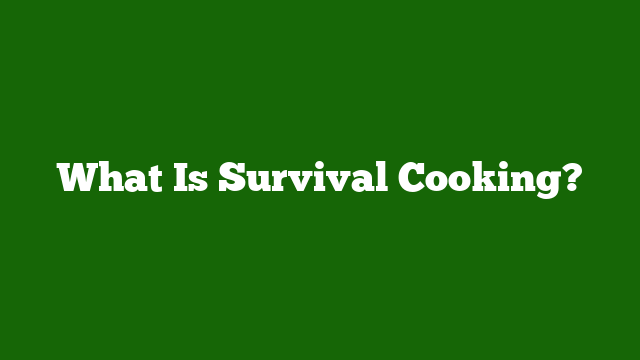Last Updated on June 12, 2023 by Umar
Survival cooking is the art of preparing meals in emergency situations or when resources are scarce.
It involves using alternative cooking methods, fuel sources, and ingredients to create nutritious and satisfying meals.
This comprehensive guide will cover everything you need to know about survival cooking, so you won’t need to look elsewhere for information.
1.
Introduction to Survival Cooking
Survival cooking is an essential skill for anyone who wants to be prepared for emergencies, natural disasters, or outdoor adventures.
It’s about being resourceful and adaptable, using what’s available to create meals that provide sustenance and comfort.
2.
Essential Survival Cooking Skills
To master survival cooking, you should develop the following skills:
- Building and maintaining a fire
- Identifying edible plants and insects
- Cooking without traditional cookware
- Preserving food for long-term storage
- Adapting recipes to available ingredients
3.
Alternative Cooking Methods
In survival situations, you may not have access to a traditional stove or oven.
Here are some alternative cooking methods to consider:
- Solar cooking: Harness the power of the sun to cook food in a solar oven or solar cooker.
- Dutch oven cooking: Use a cast-iron Dutch oven to cook food over an open fire or hot coals.
- Flameless cooking: Utilize chemical heating packs, like the Barocook flameless cooking system, to heat food without a flame.
- Earth oven: Dig a hole in the ground, line it with hot stones, and cook food wrapped in leaves or foil.
- Smoking: Preserve and cook food by exposing it to smoke from a wood fire.
4.
Fuel Sources for Survival Cooking
When traditional fuel sources are unavailable, consider these alternatives:
- Wood: Collect dry branches, twigs, and leaves for a campfire.
- Charcoal: Make your own charcoal by burning wood in a low-oxygen environment.
- Alcohol: Use denatured alcohol or high-proof spirits as fuel for alcohol stoves.
- Animal fat: Render fat from game or fish to use as a cooking fuel.
5.
Survival Cooking Ingredients and Food Storage
Stock up on non-perishable ingredients and learn how to store food properly:
- Canned goods: Vegetables, fruits, meats, and fish have a long shelf life when canned.
- Dried foods: Beans, rice, pasta, and grains are lightweight and easy to store.
- Freeze-dried meals: Pre-packaged meals that only require water to rehydrate.
- Foraging: Learn to identify and harvest wild plants, nuts, and berries.
- Hunting and fishing: Acquire skills to catch and prepare game and fish.
6.
Nutritious and Easy Survival Recipes
Try these simple survival recipes that require minimal ingredients and equipment:
- One-pot stew: Combine canned vegetables, meat, and broth in a pot and cook until heated through.
- Rice and beans: Cook rice and beans together with spices for a filling and protein-rich meal.
- Bannock bread: Mix flour, water, salt, and baking powder to form a dough, then cook in a skillet or on a hot stone.
7.
Tips for Cooking in the Wild
When cooking outdoors, keep these tips in mind:
- Practice fire safety: Clear the area around your fire, and never leave it unattended.
- Conserve fuel: Use a windscreen to protect your fire and cook with a lid to retain heat.
- Cook efficiently: Plan meals that require minimal cooking time and use the least amount of fuel.
- Clean up: Dispose of food waste properly and wash cookware to avoid attracting wildlife.
8.
Conclusion
Survival cooking is a valuable skill that can help you stay nourished and safe in emergency situations.
By mastering alternative cooking methods, fuel sources, and ingredient selection, you’ll be well-equipped to face any challenge.
With this comprehensive guide, you now have the knowledge and confidence to tackle survival cooking head-on.

